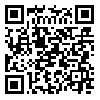Volume 81, Issue 12 (March 2024)
Tehran Univ Med J 2024, 81(12): 1008-1015 |
Back to browse issues page
Download citation:
BibTeX | RIS | EndNote | Medlars | ProCite | Reference Manager | RefWorks
Send citation to:



BibTeX | RIS | EndNote | Medlars | ProCite | Reference Manager | RefWorks
Send citation to:
Beknejadi P, Vahabzadeh D, Yousefi Rad E, Saboori S, Ghanadi K, Birjandi M. Investigation of the relationship between the dietary inflammation index and the dietary phytochemical index with non-alcoholic fatty liver diseases. Tehran Univ Med J 2024; 81 (12) :1008-1015
URL: http://tumj.tums.ac.ir/article-1-12954-en.html
URL: http://tumj.tums.ac.ir/article-1-12954-en.html
Parastoo Beknejadi1 
 , Davoud Vahabzadeh2
, Davoud Vahabzadeh2 
 , Esmaeil Yousefi Rad *
, Esmaeil Yousefi Rad * 
 3, Somayeh Saboori1
3, Somayeh Saboori1 
 , Koroush Ghanadi4
, Koroush Ghanadi4 
 , Mehdi Birjandi5
, Mehdi Birjandi5 


 , Davoud Vahabzadeh2
, Davoud Vahabzadeh2 
 , Esmaeil Yousefi Rad *
, Esmaeil Yousefi Rad * 
 3, Somayeh Saboori1
3, Somayeh Saboori1 
 , Koroush Ghanadi4
, Koroush Ghanadi4 
 , Mehdi Birjandi5
, Mehdi Birjandi5 

1- Department Health & Nutrition, School of Health and Nutrition, Lorestan University of Medical Sciences, Khorram-abad, Iran.
2- Non Communicable Disease Research Center, Ilam University of Medical Sciences, Ilam, Iran.
3- Department Health & Nutrition, School of Health and Nutrition, Lorestan University of Medical Sciences, Khorram-abad, Iran. ,esyussefirad2@yahoo.com
4- Department of Internal Medicine, School of Medicine, Hepatitis Research Center, Lorestan University of Medical Sciences, Khorram-abad, Iran.
5- Department of Biostatistics and Epidemiology, School of Health and Nutrition.
2- Non Communicable Disease Research Center, Ilam University of Medical Sciences, Ilam, Iran.
3- Department Health & Nutrition, School of Health and Nutrition, Lorestan University of Medical Sciences, Khorram-abad, Iran. ,
4- Department of Internal Medicine, School of Medicine, Hepatitis Research Center, Lorestan University of Medical Sciences, Khorram-abad, Iran.
5- Department of Biostatistics and Epidemiology, School of Health and Nutrition.
Abstract: (379 Views)
Background: The increasing prevalence of non-alcoholic fatty liver disease (NAFLD) in recent years has raised concerns about its significant risks for public health. According to previous studies, a diet with low phytochemicals and high inflammatory index is related to non-alcoholic fatty liver disease. In this study, we intend to investigate the relationship between inflammatory diet and phytochemical diet with NAFLD.
|
Methods: In this case control study, 112 newly diagnosed patients with NAFLD referred to the Shahid Rahimi Hospital clinic in Khorramabad between January 1400 and April 1401 and 112 healthy individuals without NAFLD and any other chronic diseases as the control group, with the range 23-59 years old were selected. General information, demographics, physical activity level and food intake were collected using general information questionnaire, physical activity questionnaire and valid semi-quantitative food frequency questionnaire (FFQ). The energy received between the people of the two groups was adjusted. People's diet was divided into two anti-inflammatory and pro-inflammatory groups based on the DII index based on the score quartiles.
Results: The results showed a significant relationship between DII score and NAFLD in the crude model (OR: 2.22, 95% CI: 1.04 -4.73), model I (adjusted for energy and age classification) (OR: 2.4, 95% CI:1.07-5.58), model II (adjusted for model I+physical activity, sex, education) (OR:2.77, 95% CI:1.14-6.77) and model III (model II+BMI) (OR: 2.16, 95% CI: 0.81-5.71) and DPI score and NAFLD the crude model (OR: 0.69, 95% CI: 0.32-1.47), model I (adjusted for energy and age classification) (OR: 0.56, 95% CI: 1.29-5.58), model II (adjusted for model I+physical activity, sex, education) (OR:0.58, 95% CI: 0.23-1.44) and model III (model II+BMI) (OR: 0.65, 95% CI: 0.24-1.75). Conclusion: The results obtained from this study showed an inverse relationship between following an anti-inflammatory diet and the risk of NAFLD. However, there was no correlation between receiving a diet with a high phytochemical index and NAFLD. |
Type of Study: Original Article |
Send email to the article author
| Rights and permissions | |
 |
This work is licensed under a Creative Commons Attribution-NonCommercial 4.0 International License. |



